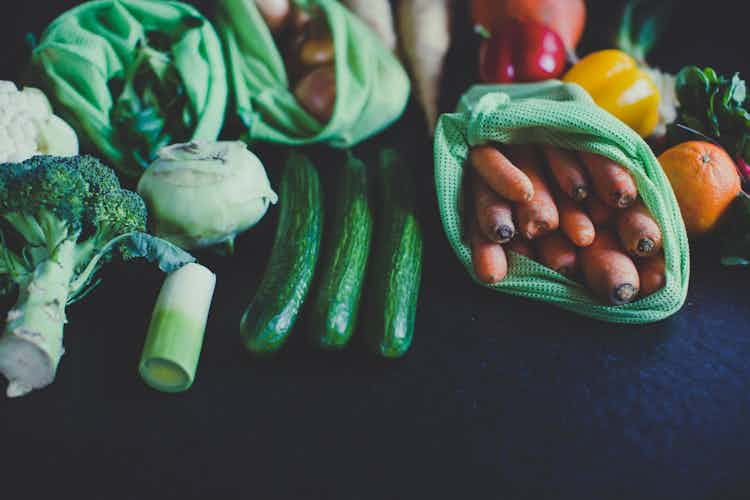Households are struggling to afford essentials as the cost of living crisis is pushing food prices up. Inflation rose to 5.5% in February 2022 and, at the time of writing, is at its highest since March 1992. Prices will continue to soar in the coming year, and families will need to spend an additional £700 on bills this year.
Against this backdrop, many households will have to budget carefully to make ends meet. Skipping meals isn't an option, and you shouldn't have to compromise on the quality of the food you buy, either.
Luckily, buying quality food doesn't have to break the bank. You can continue eating healthy, nutritious meals even if you need to adjust your spending.
Here is how.
Shop healthy staples
Fruit and veg, fresh cuts of meat, fish, and some oils make for a healthy diet. But cheap food like white bread, crisps, chips, and pasta tends to be more filling and quicker to consume. Still, there are ways to buy affordable, healthy options that keep you full without breaking the bank.
Healthy staples are also often non-perishable, meaning you can keep them longer and reduce food waste.
Here are some examples to consider:
- Brown rice is more nutritious and higher in fibre than white rice and costs about the same.
- Legumes like chickpeas, lentils, and kidney beans are high in protein and fibre and will make you feel fuller quicker.
- Canned fish like tuna gives you all the benefits of omega-3 fatty acids without shelling out for expensive fresh fish like salmon.
- Whole grains like oats and barley make for a nutritious breakfast and can even reduce your risk of type 2 diabetes and heart disease; unlike bread, they're also non-perishable.
From lentils to tinned fish, these store cupboard essentials are healthy, high-quality items that last a while and don't break the bank.
Raid the frozen aisle
Frozen fish, meat, and veg are just as good for you as fresh options but are often much cheaper and last longer. And, frozen fruit and veg tend to be prepped for you, so you don't need to worry about peeling or chopping anything before you start cooking.
For instance, while a frozen vegetable floret mix will set you back £1.15 per kilo in a popular supermarket, a similar fresh veg mix costs more than three times that amount at £3.97 per kilo.
Modern freezing methods mean there are no chemicals involved in the process and, in fact, as fruit and veg are frozen soon after picking, they will preserve all their minerals and vitamins.
If you have a big freezer, stocking up on frozen food is a great way to save while buying quality food that is just as good for you as fresh food.
Shop Reduced
Yellow sticker reductions are a great way to grab a budget-friendly bargain. Most major supermarkets offer reductions at least once a day. These are for items close to their best before or use-by date.
This means you will need to consume them fairly quickly or freeze them immediately.
But you can make some meaningful savings, with some supermarkets knocking off up to 75% of the original value.
Different supermarkets and individual grocery stores within supermarket chains reduce prices at different times during the day. So it's worth speaking to a staff member at your local supermarket and heading there early to bag a bargain.
Buy home brand items
You don't have to opt for big brand names when doing your food shop. Brand-name items aren't necessarily better quality and can cost a fortune.
A Cadbury Dairy Milk Chocolate bar costs £3 or £0.83/100g at Tesco, while a similar home brand milk chocolate bar costs £1 or £0.50/100g. If you're a fan of milk chocolate, why not make a saving by opting for the home brand option?
If you prefer crisps, a multipack of Walkers crisps will set you back £2.25, or £0.75/100g, while Tesco's own brand crisps only cost £0.43/100g.
If you want to stock up on big brand names, you may want to try Low Price Foods Ltd. From pork scratchings and macaroni cheese to peanut butter chocolate bars, you can buy heavily discounted food items.
The company keeps its prices low by selling products near their best before date, stressing that they are still safe to eat for a while after you receive them. Just make sure you don't bulk buy lots of snacks that go off before you can eat them.
For more ideas around saving money in all aspects of your life, see our helpful guide here.
Buying quality low-cost food
You can buy quality, healthy food even if you're on a budget. Stock your store cupboard with nutritious and filling essentials like lentils, tinned fish, and brown rice instead of perishable simple carbs like bread. They're better for you and last longer. Buy frozen fruit and veg instead of fresh; it costs a fraction of the price.
Switch to home brand options as they offer a significant saving. But if you really want branded food, shop reduced items or use services that sell items close to their best-before date at reduced rates.
Fiona from Financially Independent Me told us: “It’s definitely possible to eat healthily on a budget. The key is to make sure you plan your meals, and not just dinner, but breakfast and lunch, too. Salads made with grains are cheap and nutritious, and keep you fuller for longer, as will a low-cost high-protein breakfast, like porridge or eggs on wholemeal toast.
"Also, the 'convenient' snacks that are generally full of sugar tend to bump up the grocery bill. If you can plan meals that supply you with slow-release energy throughout the day, you shouldn’t need to top up on unhealthy snacks. For the most part, vegetables, grains and legumes are very cost-effective and a great way to ensure you have a balance of protein and vitamins without breaking the bank. Using a meal planner template like the one I created for myself, which is available on financiallyindependent.me or on my Instagram @fi_me1, is the best way to keep you on track, reduce food waste, and manage your budget better.”
Naomi Willis from Skint Dad added: "Instead of solely shopping at supermarkets, try to shop around to get the best overall value. Stores such as B&M sell store cupboard essentials and many have a frozen range of food. Also try your high street for a greengrocer, butcher, or farm shop, for locally produced foods. Many of them can deliver."
These are just a few key things to try if you're looking to buy quality, low-cost food.






